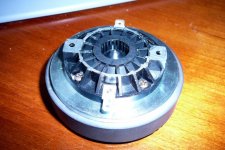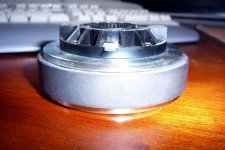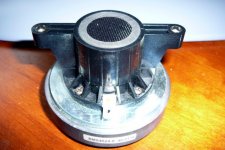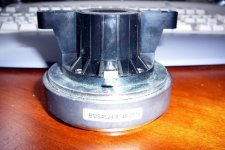Yes that pattern idea is excellent. I always find that matching to a pattern tedius and inaccurate.
Similar method was used by the old shipbuilders when making models of the big schooners...each layer followed the "waterlines"...only more advanced shapes and different tools
Those "waterlines" exist in violin bulding too, and are used fore measurements and shaping
Make a fullsize drawing of the waveguide, and draw the "waterlines" ...spacing is the thickness of used the wood...then its easy to measure each layer...do I need to say that accuracy all the way is important
Those "waterlines" exist in violin bulding too, and are used fore measurements and shaping
Make a fullsize drawing of the waveguide, and draw the "waterlines" ...spacing is the thickness of used the wood...then its easy to measure each layer...do I need to say that accuracy all the way is important
chopped up BMS 4524 good for waveguide ?
Hi.
Yesterday I decided to chop up one of my BMS 4524 drivers to get rid of the 10 degrees "tube" in front of the driver.
I think I read somewhere Earl Geddes think this would improve performance when used with a wg.
But what throat angle should I make the wg ?
My gut feeling says to make it 0 degrees, but I want to be 100% sure before I make the mold.
Here are some pics of the modified driver and an unmodified one.
Hi.
Yesterday I decided to chop up one of my BMS 4524 drivers to get rid of the 10 degrees "tube" in front of the driver.
I think I read somewhere Earl Geddes think this would improve performance when used with a wg.
But what throat angle should I make the wg ?
My gut feeling says to make it 0 degrees, but I want to be 100% sure before I make the mold.
Here are some pics of the modified driver and an unmodified one.
Attachments
The waveguide should start right where you have cut it. There shouldn't be any extension at all.
Thank you for your reply.
You mean I should make it 45 degrees if the wg is 45 degrees ?
So the only time you would make the throat angle 0 degrees, is when there is a straight tube extension in front of the phaseplug ?
You mean I should make it 45 degrees if the wg is 45 degrees ?
So the only time you would make the throat angle 0 degrees, is when there is a straight tube extension in front of the phaseplug ?
No, I think that you misunderstand. The walls are not straight at all, anywhere. There should be an immediate waveguide with an OS contour, which asymptotically approaches the design angle, but never quite gets there. The initial angle in the equations would be 0 degrees, but this instantly changes, so I was not sure what you meant.
Thanks for clearing that up 🙂
It didn´t make sense to make the throat angle 45 degrees, because then it would just be a conical horn.
I´m very excited about trying this and I think I have some reticulated foam leftover from an outdoor fish tank project, it might be too rough though.
I´ll get started on the mold today.
BTW. How is the Abbey+ going ?
It didn´t make sense to make the throat angle 45 degrees, because then it would just be a conical horn.
I´m very excited about trying this and I think I have some reticulated foam leftover from an outdoor fish tank project, it might be too rough though.
I´ll get started on the mold today.
BTW. How is the Abbey+ going ?
Kim Schultz said:Thanks for clearing that up 🙂
BTW. How is the Abbey+ going ?
I seriously doubt that an Abbey+ will ever happen. It's just not that attractive commercially. People don't want bigger and more expensive, they want smaller and less expensive. An Abbey+ would end up being too close in performance to the Summa so someone wanting this uber-performance may as well just buy a Summa.
Some data for those who might be interested. I have some DDS ENG 1-90 waveguides as well as Geddes's 12" waveguides (G12 for this discussion).
The ENG is roughly 3" deep, the G12 is 4 5/8" deep. The ENG is nominally a 10" wg whereas the G12 is 12". However, there is more differences then that.
I measured the diameter of the two WGs before the mouth roundover transition. This is not precise, its just an eyeball, but gives an idea. The ENG is only 5.5" across before the mouth roundover begins, whereas the G12 is 9" across.
More of the ENG's profile is dedicated to the mouth roundover and less to the "conical expansion" if you will.
No comments about which is better, just making some observation since the DDS is similar to Geddes' OS waveguides.
The ENG is roughly 3" deep, the G12 is 4 5/8" deep. The ENG is nominally a 10" wg whereas the G12 is 12". However, there is more differences then that.
I measured the diameter of the two WGs before the mouth roundover transition. This is not precise, its just an eyeball, but gives an idea. The ENG is only 5.5" across before the mouth roundover begins, whereas the G12 is 9" across.
More of the ENG's profile is dedicated to the mouth roundover and less to the "conical expansion" if you will.
No comments about which is better, just making some observation since the DDS is similar to Geddes' OS waveguides.
P.S. my ENG 1-90s are bolt on. I bought them prior to the move to Texas and I don't have quality issues that some reported just after the move.
Here is pic. of the progress I made yesterday.
I started by making a printout using a corrected John K WG OS 2 spreadsheet.
When opened in Openoffice it´s pretty easy to scale it to exact dimensions and when printing on my Canon printer it´s dead on.
Then I cut a large mdf disc the same size as the wg mouth, and some smaller ones ending up with the throat piece.
I then made a template after the printout and started plastering with polyester filler.
Today I´ll get some filler that hasn´t fibers in it, that is better for a smooth finish.
I started by making a printout using a corrected John K WG OS 2 spreadsheet.
When opened in Openoffice it´s pretty easy to scale it to exact dimensions and when printing on my Canon printer it´s dead on.
Then I cut a large mdf disc the same size as the wg mouth, and some smaller ones ending up with the throat piece.
I then made a template after the printout and started plastering with polyester filler.
Today I´ll get some filler that hasn´t fibers in it, that is better for a smooth finish.
Attachments
Looks good - that is the way its done. Thats a big waveguide.
Maybe you can make molds for me! Or waveguides?
Maybe you can make molds for me! Or waveguides?
gedlee said:Looks good - that is the way its done. Thats a big waveguide
This is actually only 4" deep, remember it´s for a 16.5mm throat driver and not a 1" driver.
If this goes well, I´ll try some bigger molds next.
I thought about making a steel copy of the driver mouth and using that to correct the waveguide throat to an exact fit, that way I don´t have to use the driver and risk damaging it.
gedlee said:Let me know when you can make bigger elliptical molds!
🙂 An elliptical mold will be a lot harder to make, that´s for sure.
I made some progress yesterday with the filler and painted it a couple of times with primer. Today I should have the final coats of paint on it.
Now I need to find some wax and a release agent.
Do you know if silicone oil could be used for this ?
- Home
- Loudspeakers
- Multi-Way
- Oblate Spheroid Waveguide - Consolidated Construction Thread




